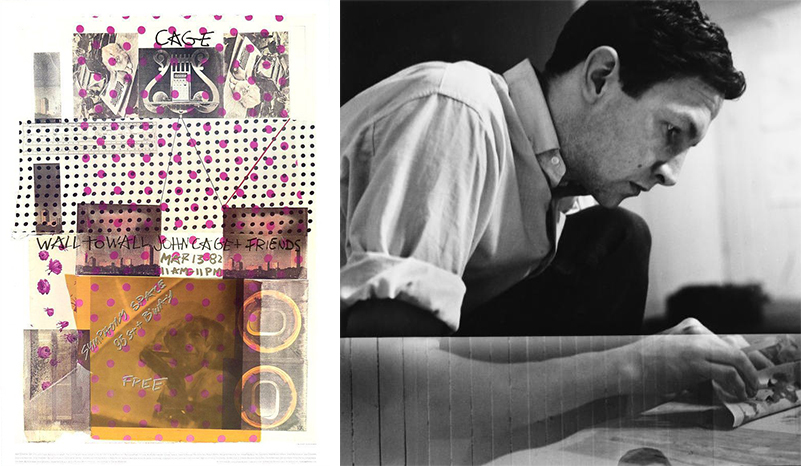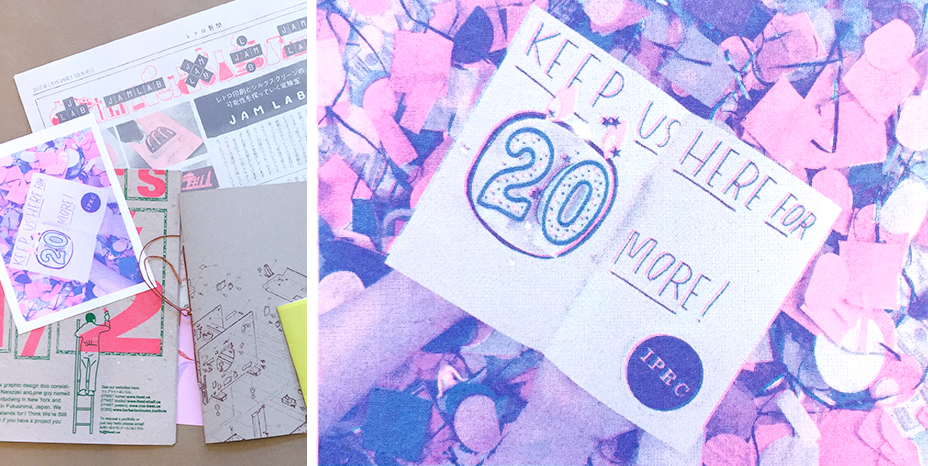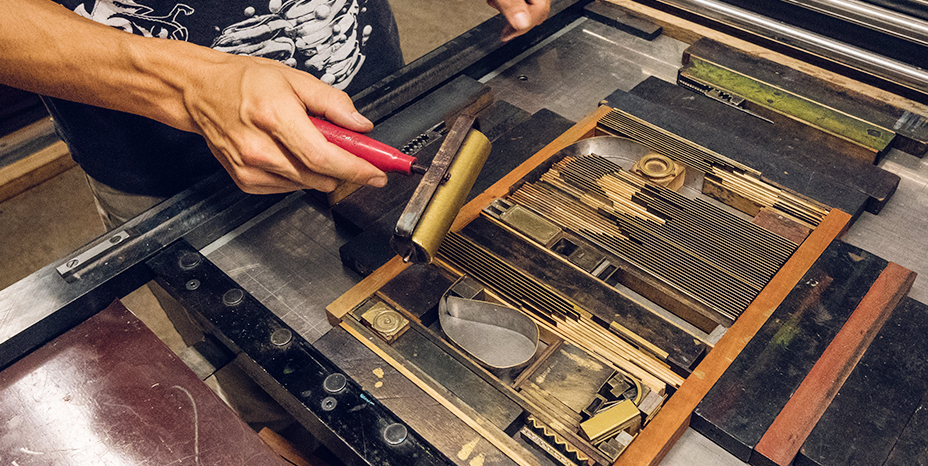Imagine that your uncle is Robert Rauschenberg and that he leaves you his printing studio when he passes away. You and your favorite art buddies adopt it as your second home, exploring all his legendary printing methods and making art experiments for hours at a stretch. That’s what IPRC feels like—a dreamy art garage with a wide array of printing equipment. Generations of Portlanders have used IPRC to screen-print show posters, letterpress cards, bind chapbooks of their poetry, meet with their writing groups, and print their comic books. You can see the evidence of their devotion—the tabletops are covered in marks from years of elbow-leaning conversations and X-Acto knife precision cuts.

Robert Rauschenberg poster “Wall to wall 1982”, Rauschenberg working on a solvent transfer drawing in his Front Street studio, New York, 1958. Photo, Jasper Johns. Courtesy, the Rauschenberg Foundation.
IPRC history
IPRC began twenty years ago when Rebecca Gilbert and Chloe Eudaly created a room for zine printing above Reading Frenzy bookstore. Now in its third location at 1305 SE Martin Luther King Jr. Blvd., the center still has a mellow, come-on-in energy. Jennifer Kim, IPRC member and volunteer, shared her experience with us:
“IPRC isn’t a utopia–it’s too warm, open, and scrappy for that. But it’s a place where they will give you the tools to create a utopia if that’s what you want to do.”
And those tools live in a huge new space—2,000 square feet, housing a wall of 20” iMacs, a screen-printing studio, a letterpress studio, a zine library, a bindery, and meeting spaces. Membership fees are radically low, and those who can’t afford the fees can volunteer to gain access. Inks are on the house—all members have to bring is paper.
New Risography Studio
The big news at IPRC is the brand-new Risography studio with classes launching this coming spring. They recently purchased three GR3750 machines with a generous supply of ink cartridges and launched a Kickstarter campaign to fund Risography clinics for members, among other studio projects. Risography machines, manufactured in Japan in the mid-1980s, allow users to scan art into a copier that prints transparent layers of ink one color at a time, resulting in a deliciously organic layering of ink on paper. The machines are made for high-speed replication and will spit out art posters at a brisk clip. This hybrid of screen-printing aesthetic and high-speed replication has gained Risography a cult following over the past few years, and the machines that have not been snapped up are selling for top dollar.

New Growth for IPRC
Kate Bingaman-Burt, illustrator, head of the PSU graphics department, and IPRC board member, has big dreams for IPRC’s future. “I feel like with this new space there’s so much potential….We’re poised for so much growth as far as programming that can be offered.
I first heard of IPRC when I was actually teaching at Mississippi State University….I was doing a zine project with my graphic design students and I found this place on the internet, located in Portland, Oregon and it sounded like this magical space, where anyone who’s interested in learning how to publish their drawings, publish their comics, publish their writing….could go and find community, and support and resources in order to help them make the work that they wanted to see in the world, basically.
We’re really lucky to have a space like this in Portland, and also one that has existed for almost twenty years, which is amazing. I feel very honored now to be a part of this organization and to be a vocal advocate for its existence. The writing, the comics community, the printing community, the social justice community. There are so many different facets that intersect here at this space. There are so many different elements that are supported by this space.”
Letterpress Studio
When you walk back into the core of the IPRC studios, those twenty years of collecting are impressive—you find yourself surrounded by tall cases of lead type, and an entire flock of letterpress machines. The iron cast presses have the gravitas of commemorative sculpture—which makes using them for personal print projects feel irreverent and euphoric. The experimental influences of the Black Mountain College and bold type-driven styles artists like Corita Kent are obvious in the prints filling the letterpress drying racks. Black Mountain College may have closed its doors, but IPRC makes sure its members can pick up the spontaneous and radical art fun right where they left off.
 Culture of Generosity
Culture of Generosity
A culture of open questioning and looking for new solutions has made IPRC a natural home for social activism and political engagement. IPRC has created a library of nearly 10,000 independently published zines, and hosts weekly binding sessions for zine artists that are new to the game. Program Director Haji Quinn explains “The concept behind movable type and its history as the means of production in the hands of the people has always been political―it’s never not been political. Access to printing presses is always political. And so I think it’s a nod to that history when you set up a political poster in moveable type.”


John Akira Harrold, IPRC’s print studio manager and designer at Pur Dubois Press, explained more detail about the ethos at IPRC. “The radically generous vibe of the studio was strengthened by former shop manager Caitlin Harris and her partner Tony Marostica. They encouraged the community to be open and inventive, never secretive or competitive. I feel like I received community mentorship and education.…I would come in and say ‘how do you do that,’and everyone was always really generous with information. It was never like a competitive thing or a secretive thing. I think Caitlin and Tony really established that. They were stoked on wanting the studio to be vibrant. So I think one of the benefits of using the studio here is that you get to be part of this learning studio practice community. I learn a lot not from a specific teacher, but from a community of printers.”
How To Join IPRC
You don’t have to be a member to hang out and work at IPRC. Anyone can design in the digital lab for $5 an hour, and use their iMacs, laser printers, and scanners at printing prices lower than Staples or Kinkos. IRPC recommends you fill out a membership application online here, then come by the center to pick up new member materials. Intro workshops are required to gain access to the print studios- the workshop fee gets you two months of free membership. IPRC is always looking for volunteers. Volunteers receive free monthly membership and can take a free class after three months.

How To Support IPRC
Donate to and share their Kickstarter Campaign. Keep the independent design accessible and vibrant in Portland.
Volunteer in the studios, and step up your printing knowledge this spring!
IPRC Studio Resources
Bindery
- Bind-Fast 5 Perfect Binding machine
- Long-arm staplers
- Stack cutter
Letterpress Studio
- 5 table-top platen presses
- 1 14×23.5″ flatbed press
- 1 30×22″ (self-inking) flatbed press
- 1 treadle operated 10×15 Oldstyle C&P platen press
- 150 diverse fonts of lead type
- 25 fonts of wood type
- Many unique engravings and printer’s ornaments
Screenprint Studio
- Re-opening with a new washout booth in January 2018.
- Exposure Unit, banded florescent light bulbs, max screen size is 35” x 26”, max image area is 27” x 29”
- Electric power washer 1700 PSI/1.2 GPM
- Wash out booth + dark drying cabinet
- 6 print boards
- Squeegees, silkscreen inks, ink additives, emulsion, reclaiming chemicals
- Large industrial paper rack shared with letterpress
Digital Lab Resources
- Five 20” iMacs with Creative Suite
- 11″ x 17″ flatbed scanners
- Black and white, color laser printers
IPRC story banner background art by Katherine Spinella, layout design by Marilee Sweeney.